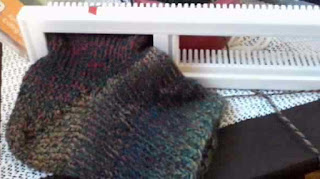The first thing I learned to make on my round loom was a sock. A pair of socks is still the nicest gift you can make with a large-gauge round loom and even learning how to do the heel and the toe is not too hard and becomes easy with practice.
Like many loomers, I started with a set of large-gauge round looms. I bought a set of the Darice looms from Amazon. Even though you need bulky yarn or to use two strands of yarn at once, there are so many different things you can do with them. For socks, I use the small, 24 peg loom and two strands of worsted weight yarn. These socks will be bulky and thick, so they are not suitable for wearing with shoes. They would be just the thing with boots or for padding about on cold floors. They are also really soft and cozy on your feet.
Since we will be making these with a turned up cuff, it doesn't matter how you do your cast on, the first row will be incorporated into the ankle of the sock.
Cast on all 24 pegs, we will knit in the round. This pattern uses the e-wrap method throughout.
Knit 14 rounds.
Now form the cuff by pulling the first row (the bottom row of your knitting) up to the pegs and with your hook, place each stitch from your first row over the corresponding peg, over the loops that are on the pegs, so that there are now two loops on each peg.
All the pegs will have two loops when you are done turning up the first row. Now pull the bottom loop over the top loop so there is just one loop on each peg. A nice trick is to tuck the tail of yarn from the first row into the cuff so it is hidden neatly.
Knit 7 rows.
Turning the heel - The heel will be worked on exactly half the peg
Increase
s. First we decrease, then we increase.
Decrease
Knit pegs 1 - 12.
Knit back from peg 12 to peg 2.
Wrap peg 1 without knitting, knit peg 2 - 11.
Wrap peg 12 without knitting, knit pegs 11 to 3.
Wrap peg 2 without knitting, knit pegs 3 to 10.
Wrap peg 11 without knitting, knit pegs 10 to 4.
Wrap peg 3 without knitting, knit pegs 4 to 9.
Wrap peg 10 without knitting, knit pegs 9 to 5.
Wrap peg 4 without knitting, knit pegs 5 to 8.
Wrap peg 9 without knitting, knit pegs 8 to 5.
Pegs 1 - 4 and pegs 9 - 12 will have two loops each. Pegs 5,6,7,and 8 will have one loop each. 4 double loop pegs, 4 single loop pegs, then 4 double loop pegs.
 |
| Wrapped but not knitted pegs on heel decrease |
Increase
Your working yarn is now at peg 5, Wrap peg 4. Three loops on peg 4. Knit the bottom two loops over the top loop one at a time - bottom loop first, then the middle loop. Continue wrapping and knitting pegs 5 through 8 normally. Wrap peg 9, three loops on peg 9. Knit bottom loops over the top loop, one at a time, bottom loop first. Knit back to peg 4. Now wrap peg 3, three loops on peg 3 and knit the bottom two loops over the top loop one at a time as previously instructed.
Continue to knit back and forth, increasing one peg on each row as above until you have three loops on Peg 1. Knit the bottom two loops over the top, one at a time, bottom loop first.
Right at the corners of the heel, you may see that there are "holes". You can fix this by pulling the back loop of the stitch on peg 12 over and place it on peg 13, then knit the bottom loop over the top. Do the same with the back loop of the stitch on peg 1 and place it on peg 24, then knit the bottom loop over the top.
Now, we continue to knit in the round as usual. The heel is done!
Sock Body
Continue to knit in the round until the sock is about 1 1/2 inches shorter than the total length you desire. About 5 inches is average for an adult sock.
Toe
For the toe, simply create it using the same method of decrease and increase as we used for the heel. So, repeat the heel instructions. However, when you have completed the toe, do not continue to knit in the round. Bind off all 24 pegs.
Finish by seaming the toe flap to the body of the sock.




























